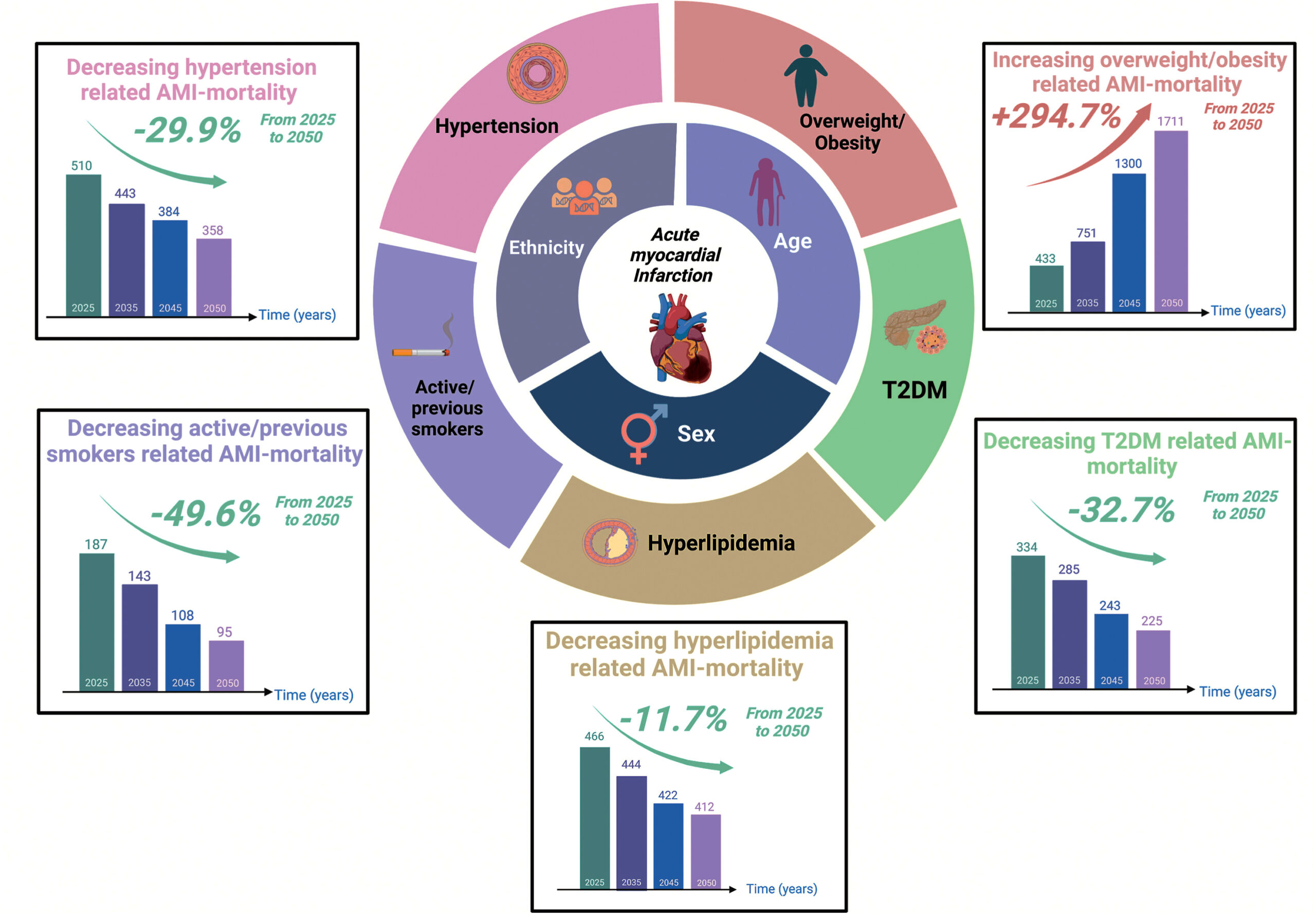
Issue 47
Aug 2023
AFFAIRS OF THE HEART

Obesity is set to become the leading risk factor for acute myocardial infarction (AMI) onset, with obesity associated AMI-related deaths projected to increase by three times (294.7%) in Singapore by 2050.
Using data from the Singapore Myocardial Infarction Registry (SMIR) from January 2007 to December 2018, researchers projected the prevalence of type 2 diabetes mellitus (T2DM), hypertension, hyperlipidemia (high cholesterol), overweight/obesity and cigarette smoking among AMI-incident and AMI-related mortality populations from 2025 to 2050, with deeper analysis based on age-group, sex and ethnicity.
AMI, or more commonly known as heart attack, occurs when blood is not able to flow to a section of the heart muscle due to a blockage in a coronary artery. The blockage, usually in the form of a blood clot, deprives the heart muscle of oxygen and nutrients, causing severe damage to affected heart issue, and this is often life-threatening.
4 in 1,000
Singaporeans will have a heart attack
In 2050,
1 in 100
Singaporeans will have a heart attack
A heart stopping future
The number of heart attacks in Singapore is projected to rise nearly three-fold (194.4%) from 482 cases in 2025 to 1,418 per 100,000 population in 2050, with obesity predicted to be the main metabolic risk factor underlying AMI onset and AMI-related deaths. In 2025, it is predicted that four in 1,000 Singaporeans will have a heart attack. With the current forecast analysis based on the current metabolic burden in Singapore, one in 100 Singaporeans will have a heart attack in 2050, according to findings from a study led by Dr Nicholas Chew from the Cardiovascular-Metabolic Disease Translational Research Programme (CVMD TRP) at the Yong Loo Lin School of Medicine, National University of Singapore (NUS Medicine). He is a clinician-scientist in the Department of Cardiology at the National University Heart Centre Singapore (NUHCS).
For every 100,000 individuals who may have a heart attack in 2050, 3,764 of them are likely to be overweight or obese compared to 384 per 100,000 in 2025. Growing by almost 10 times (880%), and overtaking hypertension and hyperlipidemia, obesity is set to emerge as the fastest-growing and leading metabolic risk factor underlying AMI onset by 2050. This worrisome increase in AMI incidence will disproportionately affect females who are overweight or obese, with more than 13 times (1,204.7%) increase in the AMI cohort by 2050. A huge increase in the incidence of heart attacks is also projected among Malays, with the number of cases per 100,000 population among obese Malays expected to rise 12 times (1,191.9%), from 803 to 10,372 between 2025 and 2050.
In terms of heart attacks leading to deaths, overweight/obesity related AMI-mortality will also see an alarming four-fold (294.7%) increase, as opposed to the declining trends in AMI-related mortality associated with other risk factors like T2DM, hypertension and active/previous smoking. The largest rise in AMI-related mortality over time is predicted in Malays with a five-fold (419.3%) increase, followed by Indians with a three and a half times (253.5%) rise.

Trends and predictions of acute myocardial infarction and its associated metabolic risk factors from 2005 to 2050.
Shaping a hearty future
The good news? Researchers say that the upward projected AMI trajectory can be halted by reducing upstream metabolic risks through the early detection and treatment of subclinical diseases in vulnerable groups. Nationwide programmes focused on strengthening heart health can also potentially critically change the course of obesity-related deaths.
We have to move away from a ‘one-size-fits-all’ approach to address challenges faced by groups at risk of AMI-onset and mortality. For example, the rise in obesity as a risk factor for metabolic disease morbidity is more predominant in younger and middle-age groups, whereas metabolic disease mortality for older populations is driven by hypertension and hyperlipidemia. This necessitates differentiated interventions.”
194.4%
from 2025 to 2050
“We have to move away from a ‘one-size-fits-all’ approach to address challenges faced by groups at risk of AMI-onset and mortality. For example, the rise in obesity as a risk factor for metabolic disease morbidity is more predominant in younger and middle-age groups, whereas metabolic disease mortality for older populations is driven by hypertension and hyperlipidemia. This necessitates differentiated interventions,” said Lead author, Dr Nicholas Chew.
Epidemiological insights gleaned from the population-based analysis in this study can also potentially inform future global responses to cardiovascular-metabolic diseases.
Said Associate Professor Mark Chan, Deputy Director of the CVMD TRP at NUS Medicine and Senior Consultant in the Department of Cardiology at NUHCS, “There are many European and U.S based studies that have explored the cardiovascular disease trajectories in predominantly Western populations. However, few studies forecast trends that are representative of an increasingly multi-ethnic Asia. The trends identified in this study is a good representation of larger, emerging trends in rapidly-growing Asian societies due to Singapore’s rapid rate of socio-economic development and our multi-ethnic case mix.”
The study, collaboratively undertaken by Dr Nicholas Chew, NUS Medicine Phase IV student Bryan Chong and Kuo Si Min, Senior Manager at Health Promotion Board, Ministry of Health, was published in The Lancet Regional Health-Western Pacific on 31 May 2023.
More from this issue

A WORLD IN A GRAIN OF SAND
Neutrophils and NETs in Microbial Infection and Pneumonia
OFFICE FOR STUDENTS
Community Service Programme Gives Students Practical Learning Opportunities


